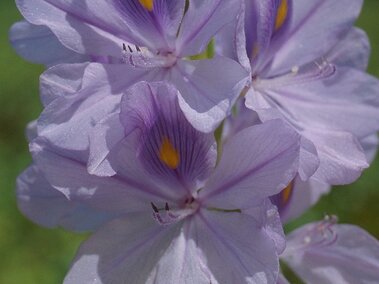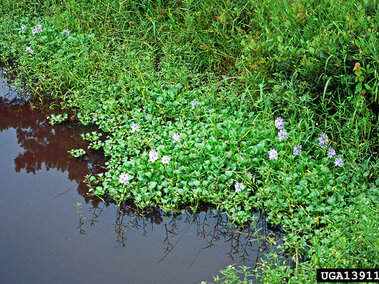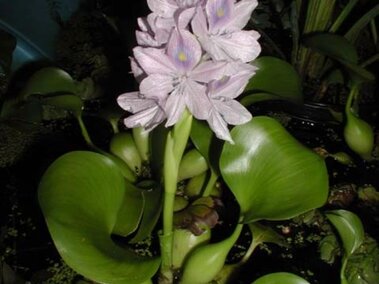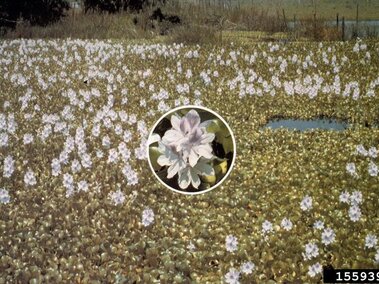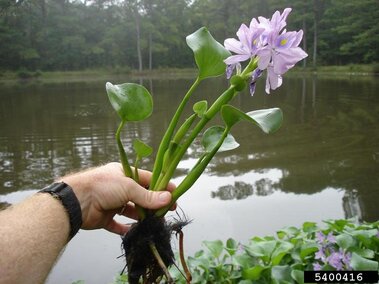General Information
Species Name: Eichhornia crassipes
Also Known As: common waterhyacinth, common water hyacinth, common water-hyacinth, floating water hyacinth, water hyacinth, water-hyacinth
Family: Pontederiaceae (Water-Hyacinth Family)
Growth Form: Forb (aquatic)
Life Span: Perennial
Flowering Dates: May-September
Origin: South America
Noxious: No
Category 1: Potential Aquatic Invasive Species
Why Is It Invasive?
Water hyacinth is a fast growing, troublesome aquatic plant. It produces large floating mats of dense vegetation, which reduce light penetration, impede recreation, and produce mosquito breeding habitat. In addition to blocking navigational routes and irrigation channels, it can clog hydroelectric turbines, reduce fishing areas, and restrict livestock access to water.
What Does It Look Like?
General Characteristics
Water hyacinth is a free-floating plant with clusters of waxy leaves, but occasionally roots in mud when stranded. Long, dark roots dangle below the plant. Roots are highly divided and feather-like in appearance.
Flowers
Showy purple flowers in clusters on a spike held above plant. Upper lobe has darkened spot with a yellow center.
Leaves
It has broad, rounded leaves with inflated bases form free-floating rosettes. Leaves are glossy, and can be up to twelve inches long from base to tip and up to six inches wide.
Stems
It is a rosette-forming plant, with a circular arrangement of leaves at about the same height and little or no stem developing between the roots and the leaves. Rosettes are interconnected by horizontal stems called stolons, forming dense mats that eventually cover the water surface. Submersed roots are usually bluish- to purplish-black in color and have a feathery texture.
Seeds
The fruit are three-celled, ovoid capsules to ½ inch long, each containing up to 300 tiny, longitudinally ribbed seeds.
Photos
Where Does It Grow?
Water hyacinth grows in shallow temporary ponds, wetlands and marshes, sluggish flowing waters, lakes, reservoirs and rivers. Plants can tolerate extremes of water level fluctuation and seasonal variations in flow velocity, and extremes of nutrient availability, pH, temperature and toxic substances.
How Does It Spread?
Water hyacinth was introduced to the United States as an ornamental at the World’s Industrial and Cotton Exposition in New Orleans, Louisiana, in 1884-1885. A visitor to the exhibition brought the plant to Palatka, Florida, and planted it in an outdoor fish pond and around a boat dock on the St. Johns River. By 1896, it was reported to have covered a 200-mile stretch of the river. Water hyacinth flowers year-round in mild climates, with established mats of plants producing enormous quantities of seed, which can remain viable up to 20 years. Plants also reproduce readily from stolons. Growth rates are explosive, with mats doubling in size in a matter of weeks under favorable growing conditions. Plants are easily moved by both wind and water currents. Rosettes and stolons are also dispersed by boats and boat trailers.
How Do I Control It?
Management of invasive aquatic plants involving either mechanical removal of plants or application of herbicides to public waters requires a permit. Contact the Contact the Nebraska Game and Parks Commission for more information.
Mechanical
Cutting or pulling the plant by hand or with equipment such as rakes or cutting blades could break it into fragments, allowing it to further spread. Contact the Nebraska Game and Parks Commission to determine appropriate removal methods.
Cultural
CLEAN your watercraft, trailer, angling gear and other equipment. Remove all aquatic vegetation and animal species from your equipment.
DRAIN your watercraft at the ramp by removing the boat plug and draining all live wells and ballast tanks.
DRY your watercraft, trailer and other equipment for at least 7 days before visiting another waterbody.
DON'T LET IT LOOSE. Do not release or transport exotic or non-native fish species to new ecosystems, and do not dump aquariums. It is unlawful to release any aquatic species into a waterbody other than the one from which it was harvested. Doing so can promote the spread of AIS.
Chemical
Application of chemicals to public waters requires a permit. Contact the Contact the Nebraska Game and Parks Commission for more information.
What Should I Do If I See It in Nebraska?
If you see water hyacinth in Nebraska, you should report it to the Nebraska Game and Parks Commission's Aquatic Invasive Species (AIS) Program using their AIS Report Form. For guidance on what information to include in your report, check out our reporting tips.
References and More Information
Center for Aquatic and Invasive Plants
Center for Invasive Species and Ecosystem Health
Florida Department of Agriculture and Consumer Services
ISSG Global Invasive Species Database
Nebraska Game and Parks Commission
University of Minnesota Extension

